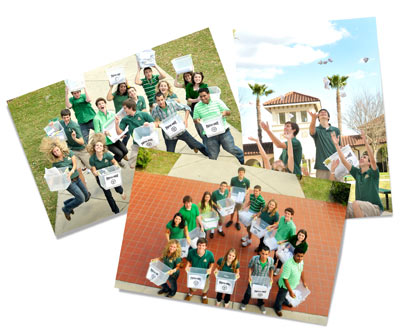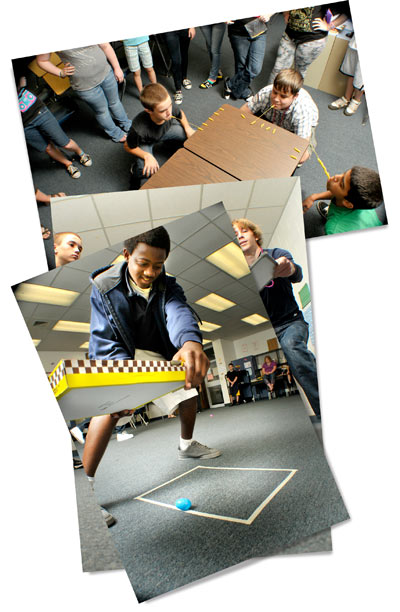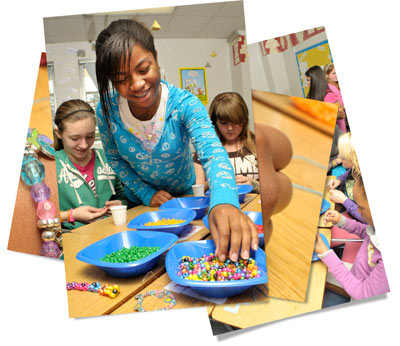
With advancements in technology and access to a wider range of information and ideas, clubs today are a whole lot different!
While sports still draw a huge turnout, local schools are offering a brand-new generation of after-school options. With everything from the Japanese art of anime to beading and recycling, these clubs bring new meaning to the word ‘extracurricular.’

Green Club, Trinity Catholic
One thing schools are known for is their overabundance of paper. While many aspects of classroom work have advanced into the digital age, some assignments still require good, ol’ white paper. A spelling test certainly wouldn’t be much of a challenge with the spell check turned on!
To some of the kids at Trinity Catholic High School, though, seeing mounds of paper stuffed in a trash can is just not acceptable. Three years ago former student Haley Steer along with her sister and current senior Heather Steer founded the school’s first Green Club under the guidance of math teacher Linda Steer.
Today with over 40 members, Trinity’s Green Club is doing its part to make Ocala a cleaner place, while at the same time hoping to inspire other area schools to start environmental clubs of their own.
“These kids are all so dedicated,” says Linda as she watches her rubber glove-wearing students pick up trash around Scott Springs Park, one of their monthly duties.
Aside from park cleanup, the major project that Trinity’s Green Club established is the paper recycling program throughout the school. The club raised funds to purchase recycling bins by selling reusable water bottles for $5 each. Now, every classroom, library and office has a bin for paper next to the trash can.
“Bins are expensive, so it’s been a slow process,” says Linda. “We now have about 65-70 bins a week that we take to the recycling center.”
Club members are responsible for collecting the bins on a weekly basis, which is no small task since bins filled with paper are both heavy and cumbersome. Once all the bins are collected, the students pile them into their own cars and take them to the recycling center. Though it may seem a simple task, Linda knows how busy students are these days with other after-school activities. Their commitment to the program is what keeps the Green Club alive.
“It’s a way to clean up our environment and do our part,” explains junior Keeley Shields, “even if it is a small one.”
The club’s long-term goal is to be able to recycle everything on campus, including bottles, plastics and aluminum. However, the expense of hiring a company to pick up these items currently exceeds the club’s budget.
“It’s a shame we can’t recycle bottles right now,” says senior David Dean, “but this is just the start.”
The club’s overreaching goal is to encourage the creation of green clubs in other area schools.
“We want the trend to spread,” says co-founder Heather Steer.

Win It In A Minute Club, Lake Weir Middle School
Uncooked spaghetti hanging out of one kid’s mouth, pencils soaring through the air, plastic eggs being fanned down the hallways—these are just some of the sights you’ll see at Lake Weir Middle School. No, the students haven’t run amok. They’re participants in the schools’ newest club, Win It In A Minute.
Based on the popular NBC television show, Minute to Win It, the Lake Weir club was founded this past school year by eighth-grade math teacher Diane Royals and fellow teachers Beth and Andy Bordelon.
“I saw it on TV and thought it was such a clever idea,” says Diane.
And with over two decades of experience as a teacher at Lake Weir Middle, she has a pretty good idea of what keeps kids entertained.
The club meets once a month on an early-release day. The first meeting is a designated practice session where the five games are selected and each student learns the rules and practices. The next meeting is when the fun begins and the kids’ competitive spirits come alive.
“We based our games off of NBC’s, but we don’t have the money they do so our prizes aren’t as exciting,” laughs Diane as she sets up the pasta for “6 Penne Noodles on Espegueti.”
In this game, each child puts a piece of uncooked pasta in their mouths and has one minute to scoop up six pieces of uncooked penne pasta without using their hands.
Meanwhile pencils are taking flight next door in a game of “Pencil Pickup,” where students have one minute to toss and catch pencils using one hand. After each catch, the number of pencils grows by two until 12 pencils at a time are being tossed.
Step into the hallway next, but be careful not to step on an egg as the game “Fan the Egg” proceeds. Kids rapidly fan pizza boxes in an effort to propel their egg into the goal.
“We figured it would be safer to use plastic eggs instead of the real thing,” adds fellow club mentor and eight-grade intensive reading teacher Beth Bordelon.
The club is a big hit among the students. Seventh-grader Leighanna Marshall says she’s been watching the show since it first aired and loves being in the club. Sixth-grader Elaina Kluge’s favorite game is the “Cookie Game,” in which students have one minute to move a cookie from their forehead into their mouth without the use of their hands. The incentive of a tasty treat encourages Elaina to practice as often as possible.
While a more traditional club would certainly be easier for the teachers to organize, the hard work pays off for Diane when she sees her students’ enthusiasm.
“The kids just love it,” she says.

Anime Club, Vanguard High School
Let’s get one thing straight: Anime is not just a cartoon. And if you ask the self-proclaimed anime-nerds (or “otaku” in Japanese) who make up Vanguard High School’s Anime Club, they’ll be quick to defend their interest.
“You can’t compare anime to other cartoons like SpongeBob,” says club president Johnathan Nesbitt. “It just won’t work.”
Unlike “other” cartoons, an anime series usually follows a progressive storyline and is a continuous series featuring well-developed characters. What makes these cartoons special, adds Johnathan, is that there’s something for everyone.
“It’s not just for kids,” he says.
Whether you’re a fiend for vampires, a nut for robots, a devotee of drama or an action aficionado, there’s an anime for virtually every interest. And it’s that broad audience appeal that brings the kids together in one club.
Alli Swango, the club’s treasurer, believes that making friends is one of the best benefits of being a club member.
“It brings so many people together,” she says. “You can get someone involved even if they hated [anime] to begin with.”
The kids’ common interest in anime is so strong that it has brought them together from all over the county. In fact, Janise Hope says the club was the deciding factor when choosing a high school.
“It’s hard to find people with the same interests,” explains Janise, who is the club’s secretary.
So when she was accepted into both the AICE program at Belleview and the IB program at Vanguard, Janise chose the latter as an opportunity to make more friends.
The colorful Japanese-style illustrations that unite these students usually come from black-and-white mangas, which are the equivalent to American comic novels. Right now, the members are in the process of writing their own manga, which the club’s vice president Kiane King plans to pass on to future generations of Vanguard’s otaku. They even meet up outside of school at the public library to work on their story, hoping that one day it may be published.
Kiane has a copy of her favorite manga on-hand, and she is quick to point out Elliot March, a character from the Japanese version of Alice in Wonderland. Kiane is currently working on duplicating Elliot’s costume for cosplay, their version of dress-up. But because the school’s dress code limits what they can wear and Kiane’s costume won’t be complete without Elliot’s bunny ears, they are planning on setting out to Tampa in June for MetroCon, the biggest anime convention in Florida.
In school, the club members challenge each others’ knowledge in Jeopardy-style trivia games and test their skills in art contests. In the Fan Art Contest, members are encouraged to enter any kind of original anime-related artwork, song or story.
“Some of them are tremendous artists,” says sponsoring teacher Robert Hoki. “This club is a club of bright people.”
The entries are posted on their Facebook group page and judged by three selected club members. One of their favorite prizes is a Japanese snack called Pocky, a chocolate-dipped biscuit stick, along with bragging rights, of course.

Beading Club, Lake Weir Middle School
Considering that many students at Lake Weir Middle School misheard the name of the new beading club as the “beating club,” the group didn’t start with a huge turnout. But now that its name has been clarified, the club weighs in at about 43 students strong.
The Beading Club meets once a month to exercise members’ creativity by stringing beads together to make bracelets, pins, keychains and lanyards.
With kitty cat keychains on one side of the room, ladybug lanyards on the other and St. Patrick’s Day pins somewhere in the center, the members clump into groups based on their interest in that week’s project. At each meeting, the students are given a new assignment, handed instruction sheets and provided with spools of string and a rainbow of beads.
But for some members, gathering once a month is not enough to meet their beading needs. Eleven-year-old Ayana Guerrero was so zealous about her creations that she asked for money for Christmas to buy beads so that she could make necklaces at home.
Abigail Ellis also has become a do-it-yourself beading expert at age 12. She proudly describes her own little beading corner at home and how she has graduated from plastic beads and string to metal beads and wire.
Thirteen-year-old Brittany Lankford walks into the classroom sporting an impressive collection of bracelets that climbs halfway up her forearm. Some were done in the club and some at home, she says.
“I just like bracelets,” she explains, adding that a perk of the club is getting to hang out with friends.
Patricia Cormier, one of the teachers who founded the beading club, says the students love it because it gives them an excuse to talk without getting in trouble.
“It kind of reminds me of those crocheting and knitting clubs that old ladies have,” she says. “They can just get together and chat.”
But the club is more than just an outlet for chatty children. Cormier says it strengthens the essential socialization skills that are lacking in a generation dominated by electronic communication.
For its first year, the club has proven extremely popular, especially among girls. It’s a good thing for them that Cormier and the two other founding teachers, Shannon Taylor and Debra Durden, came up with the idea to replace last year’s overgrown scrapbooking club.
Cormier hopes that as the year goes on her students can start working with smaller beads and practice more advanced projects like making earrings (surely another surefire hit with the girls). And as the club continues to grow, she says this one will definitely live to see another school year.

Whodunit? Club, Hale Academy
Was it Miss Scarlet in the library with the candlestick? Or perhaps Professor Plum in the ballroom with the wrench?
Well, that’s all elementary for the middle-school detectives in Hale Academy’s Whodunit? Club.
Every Wednesday, usually three girls and one boy meet up with history and literature teacher Jane Levine for 40 minutes of mystery-book reading as well as suspect-spotting, brain-picking and case-cracking. Although the group is small, the students are passionate about what they do.
“I knew Ms. Levine taught interesting things and I love that,” says Devon Quinton, 13. “You’re learning and enjoying, and you don’t always get that.”
The students learn how to pay attention to details, pick out clues and decode the red herrings, or literary curve balls, that authors throw into their stories. While the students act out characters in the story, Jane interjects to point out important facts or provoke with questions. “Why would they want to do that?” she will ask her students. Or “do you think this is important to the mystery?”
“We’re definitely training suspicious minds in this class,” Jane laughs.
“You can’t trust everyone. I’ve already learned that,” agrees 12-year-old Aimee Sanchez. “Sometimes you have to be suspicious.”
Each teacher at Hale is responsible for coming up with a club, and for Jane, the choice was easy. She grew up reading mystery novels with her mother, and to this day, the pair still solves cases together. As a teacher, she believes the skills that students gain from thinking logically through the mystery-solving process can apply to other areas of learning and education.
For the introductory meeting, Jane enlisted the help of the Spanish teacher, dressed in a variety of costume pieces. Jane had placed three objects on the table in front of the club members that the Spanish teacher “stole” as she dashed past the students and raced out of the room.
Each member had to write down immediately as much as they could remember about what she took and exactly how she was dressed.
“It was very eye-opening to discover the discrepancies in what they thought they saw,” Jane says. “Totally different colors, objects, etcetera, yet everyone could have sworn they saw what they saw.”
Jane wanted the club members to see how unreliable eyewitness testimony can be, and she certainly succeeded in proving that you often can’t trust your own eyes.
Just before reaching the end of this particular week’s story, Jane and the students stop to take predictions on the conclusion.
“So, who did it?” the students ask as they try to coax Jane into giving up the answer.
“I don’t know,” she responds simply and then smiles.
The five clubs featured in this article are surely unique, but by no means are they the only ones in Marion County worth mentioning. Here is a handful of other area quirky clubs that your child just might want to consider joining:
Sewing Club, Fort King Middle School
Cup Stacking Club, Fort King Middle School
History of Rock ‘n Roll Club, Lake Weir Middle School
Gameboards Club, Lake Weir Middle School
Jigsaw Puzzle Club, Lake Weir Middle School
Step Club, Lake Weir Middle School & Belleview High School
Tumbling Club, Lake Weir Middle School
Archery Club, Liberty Middle School
PC Gamers, Belleview High School
Gaming Club, Lake Weir High School
Criminal Justice Club, North Marion High School
Film Fanatics Club, Hale Academy
Quilting Club, Hale Academy
Robotics Club, Cornerstone School/EMIT & Grace School
EcoKnights Club, Vanguard High School
Living History Club, Trinity Catholic High School






